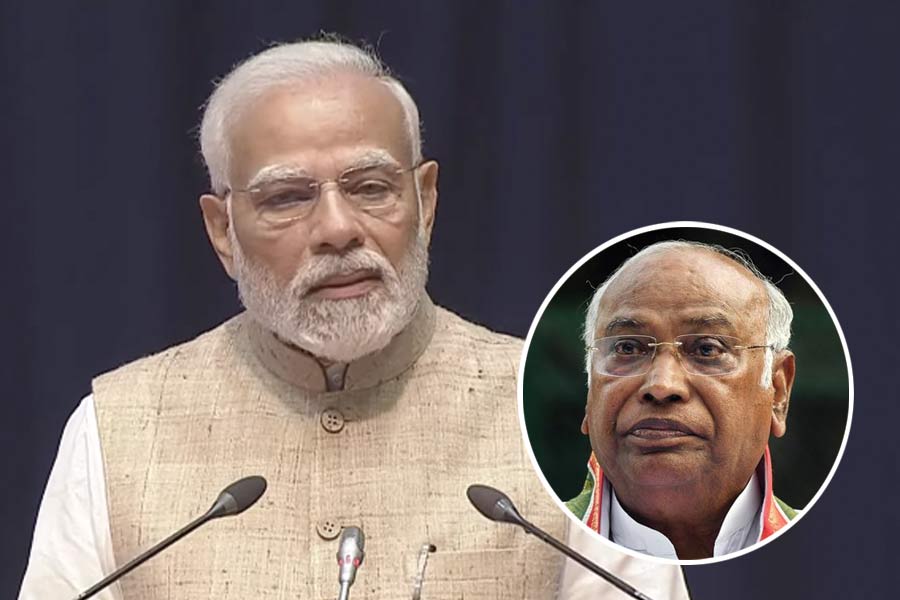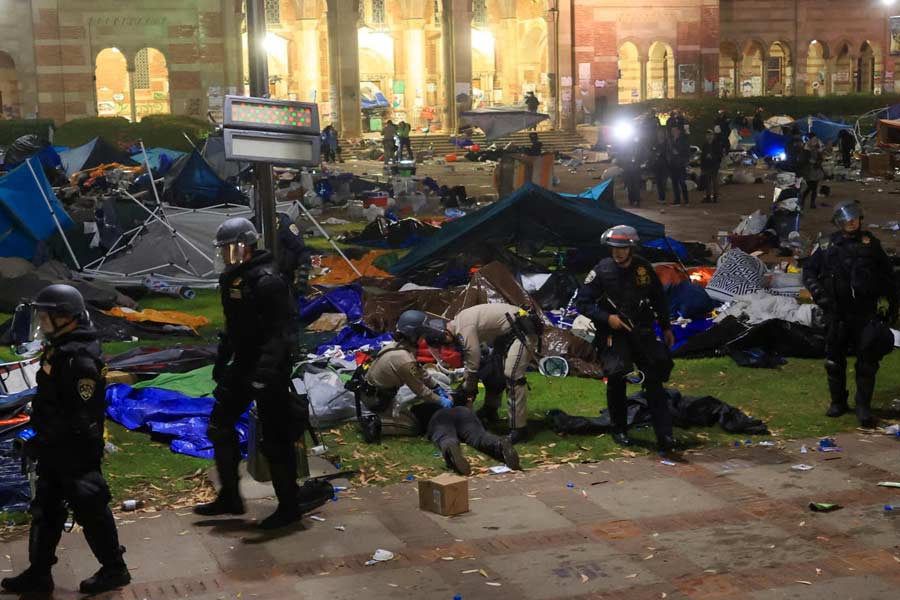In a letter to the artist, Asit Kumar Haldar, Abanindranath Tagore asked him not to be a gurumoshai and frighten students when teaching in “Bolpur”: “Remember, to teach birds one must turn into a bird too.” By Bolpur, Abanindranath meant Kala Bhavana, the fine arts school that Rabindranath Tagore had begun in Santiniketan. It started operating as a separate entity — not part of the original school — from 1919, two years before Visva-Bharati was recognized as a university. The relationship between teacher and student suggested by Abanindranath was intrinsic to his uncle’s idea of education and, according to artists from all over the country who have learnt or taught in Kala Bhavana, is one of its enduring features. This alone — overturning a traditional hierarchy — would put the institution at odds with today’s regime. In an address in Chennai called “The Centre of Indian Culture” in 1919, Rabindranath Tagore had said that “the mission of all education is to lead us beyond the present date...” This idea underlay the statement of the art historian, R. Siva Kumar, a former student, teacher and principal of Kala Bhavana, at the Kochi Biennale in 2017 that the contingent nature of preparations for the future required teachers to be learners too, fellow travellers with their students.
Although going beyond hierarchies — embedded structures of power — is a mirage in the present political ethos, what remains undefeated is the other kind of power that Rabindranath’s ideas about teaching and the place of art generated, permeating the thinking, working and teaching of many of the artists and historians of art who have passed through or still inhabit the world of Kala Bhavana. Yet in its 100 years, the institution, together with the university of which it is part, has undergone numerous changes. In 1933, Sangit Bhavana took over music and dancing from Kala Bhavana, but the watershed came when Visva-Bharati became a Central university in 1951, subject to all the pertinent rules. But the procession of matchless artists who worked and taught there, beginning with Nandalal Bose, Benode Behari Mukherjee and Ramkinkar Baij, continues unbroken, like a still potent flowering of the unknown future implicit in the founder’s dreams for art and education.
The breakdown of hierarchies was a determining element in Rabindranath’s ideas of learning. In “Kalavidya”, where he promises that the teaching of music and the fine arts would have a major role when Visva-Bharati became a university, he says that human beings express their inner love and desire not only by creating beauty in everyday objects, but also through music and the fine arts. The equality implied here demolishes traditional divisions between ‘high’ art and ‘craft’ while absorbing the energy of folk traditions. Education is pointless unless it brings us into an “organic connection” with our surroundings, Rabindranath said in the 1919 Chennai address, expressing his belief that “our educational institutions should be in the very heart of our society, connected with it by living bonds of varied co-operations”.
The politics implicit in this vision has a broad and eventful context. A few months before Nandalal Bose took charge of Kala Bhavana, Tagore had written to Lord Carmichael, returning his knighthood. Jallianwala Bagh had hurt him deeply — and it had nothing to do with the attachment to rigidly nationalistic ideals which he had by then overcome. That aggressive nationalism and communal conflicts surrounding the partition of Bengal in 1905 put him off is clear in novels such as Gora and Ghare Baire, and he repeatedly spoke about the limitations of nation-based patriotism. But he did attribute the joylessness of life to Europe’s introduction of machines — as did William Morris, poet, writer, artist, designer, craftsman and a Socialist with an unflagging belief in the power of art to transform life — and in “Kalavidya”, Rabindranath described art as the expression of a human being’s inner vitality, without which a race loses its love of life, even the ability to work. He put down neglect of art education in India to the single-minded pursuit of an English-based education aimed at jobs.
While establishing fine arts education as an integral part of university life, Rabindranath emphasized the diversity of personalities that found expression in art. Nurturing diverse abilities, expressions, techniques and forms while breaking the barriers between outside and inside, connecting the university with the busy lives and activities surrounding it, also meant destroying less visible power structures. Diversity, too, is unpopular now. At the time, Rabindranath believed that the traditions of Indian art had been obstructed, but pure revivalism did not satisfy him. He wished for a new art, in touch with the contemporary and open to the world, both East and West. Sending back the artist, Kampo Arai, from Japan, he wrote to Gaganendranath Tagore that our consciousness is keenly awakened when prodded by a new stimulus from outside. That Stella Kramrisch came to deliver 43 lectures on Western art was one outstanding instance of his efforts at sharing stimuli.
The politics of his art education grew in inclusiveness. The First World War had deepened his conviction of the evils of narrow nationalism while suggesting the possibility of creating peace through bonds of culture. Nationalism — blind loyalty to the nation-state — brought out the most aggressive and selfish elements in people, he said in 1919, while culture was open-ended and dynamic, allowing creative sharing and the building of international alliances. He wrote to his son in 1916 that he wished to make the school at Santiniketan “a link between India and the world”. On Bengali new year’s day in 1918, he said to the students that “our ashram has raised no walls, drawn no boundary lines”. Visitors arrived from different parts of the world, “crossing all hurdles — of oceans, nationhood, region-born customs, religious practice”. Hoping in 1916 for a centre in Santiniketan that would “study humanity across all races and nations”, he gave it clearer shape in 1919: “... [I]n our centre of Indian learning we must provide for the co-ordinated study of all these different cultures — the Vedic, the Puranic, the Buddhist, the Jain, the Islamic, the Sikh and the Zoroastrian. And side by side... the European...” Besides living languages, folk literature would be studied too, to understand the psychology of “our people” and the direction in which “our underground current of life is moving”.
Of course he was not alone in this venture; he had around him and after him people who through dedication, sacrifice, wisdom and belief in the vision made it as realistic and practical as possible. Change is inevitable, but it is amazing that the meanest of politics, academic and otherwise, has not — so far — been able to uproot the greater politics at the service of education, art, co-operation, cultural dynamism, the sense of fulfilment and freedom that determines the inner structure of the institution. It is, therefore, somewhat disconcerting to have the chancellor of the university tell students at the convocation that they should rise above their own interests and adopt a ‘nation-first’ approach. Sadly for us, in 1916, Rabindranath had thought that “the age of narrow-minded nationalism is approaching its end”. But was there a message in the chancellor’s reference to highly educated people spreading terror at a time when the prisons are full of students charged with sedition and ‘unlawful’ activities and Disha Ravi had been arrested? Visva-Bharati students were given a new kind of choice — of being the problem or its solution. Since thinking nation-first was the cure-all, the choice had not existed at all. The present vice-chancellor, meanwhile, is frankly impolite — to a degree that does not bear repetition. But it is the chancellor, the vice-chancellor and their cohorts that make the news, not Kala Bhavana’s centenary.
Perhaps the choice Morris offered in his 1881 lecture, “Art and the Beauty of the Earth”, is the one we must make: “So, which shall we have, art or dirt?”










